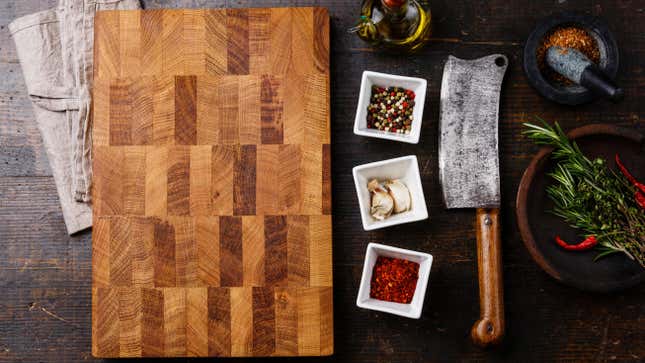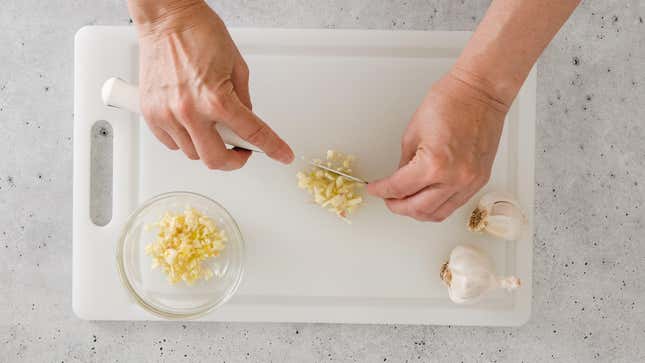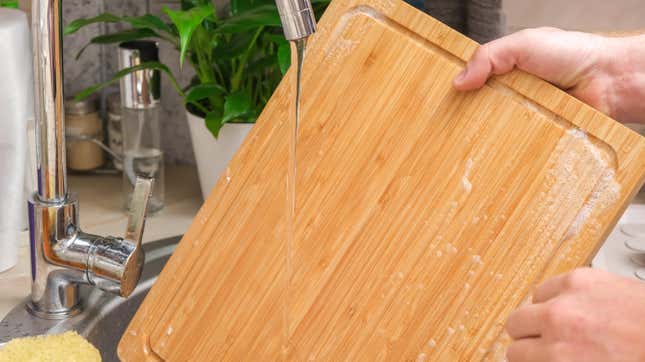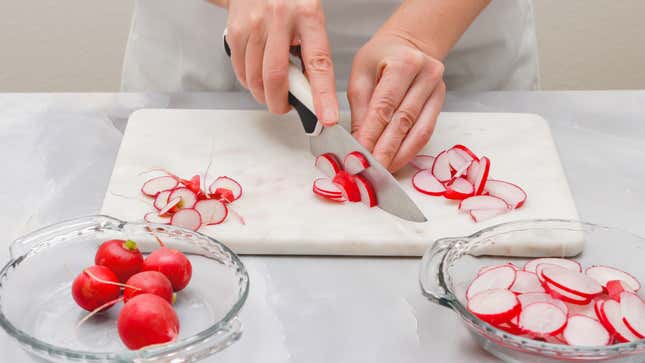Having a quality knife you can depend on is only half of the cutting equation. A knife needs to be maintained with honing and sharpening, but knife care extends to the cutting board. Cutting boards provide you with a large, stable surface for slicing and dicing, and they can make clean up a whole lot easier, but the some cutting boards can shorten the lifespan of you knives. Here’s an overview of the materials you should look for in a cutting board, how to care for them, and what to avoid.
End-grain hardwood cutting boards are worth the investment

The best material for a cutting board is something hard and durable, but with a fair amount of give, so the blade of your knife doesn’t get dulled, or worse, chip. Most professionals would recommend hardwood, like maple, acacia, beech, cherry, or walnut, and end-grain is touted as the best arrangement. Imagine a two-by-four. There are the long, smooth sides and the rougher end-sides. You want that rough side. This part of the wood provides a softer surface for the blade to hit up against; the exposed wood grain can “catch” the blade. End-grain hardwood usually looks like a chessboard made up of those ends.
End-grain cutting boards can be an investment. They’re some of the most beautiful and longest-lasting boards, but they’re also some of the priciest (and heaviest). A thicker board will be more expensive, but less prone to warping. With correct care, they can last decades.
When you appreciate beauty with a purpose, go with an end-grain cutting board:
Never ever ever put your gorgeous end-grain cutting board in the damn dishwasher. Never. You paid a lot of money for that board. Treat it with kindness. Hot dishwasher water, combined with harsh detergents and long washing cycles can damage, crack, and warp any wood board.
Instead, hand wash it and blot dry. Drip drying is OK, but you don’t want to have any standing water puddling on the wood for long periods of time. Once a month, generously apply food-safe wood grain oil to the board, and allow it to sink in for one or two hours. Wipe off the excess. To keep the board looking its best, wax it once a month after oiling. Apply a layer of wax evenly, over all parts of the cutting board, and allow it to cure for a few hours or overnight. Buff off the excess with a lint-free cloth. This will help seal the board, prevent knife marks from forming, and keep bacteria from collecting in any scars.
Plastic cutting boards are practical and easy to clean

Like wood boards, plastic cutting boards are durable, yet soft enough to preserve the cutting edge of a knife. A quality plastic cutting board is great for cooks that appreciate something that’s low-maintenance, light, and thinner than a wood cutting board. Plastic doesn’t need an oil and wax spa treatment; it can usually go in the dishwasher without getting damage, it stores easily, and you can find great ones for at affordable prices. Most professional kitchens use plastic cutting boards.
There are a few downsides to consider. Plastic isn’t as pretty as wood. While wooden boards make lovely display pieces for charcuterie, I never use my plastic board for serving guests. Plastic also scars, and needs to be replaced more often. When you cut into a plastic board, the plastic will give. After multiple cuts, deep slices can develop, and thin shavings of plastic can come off (and sometimes go into your food). Bacteria can grow in these caverns, and plastic can hold onto odors. Eventually the board needs to go. I’ve noticed, unsurprisingly, the cheaper and thinner the board, the sooner these cuts develop and lead to plastic shavings falling off into your ingredients.
Plastic boards that balance quality and affordability:
Look for a plastic board that is at least 1/4-inch thick. I haven’t met an ultra-thin, flexible plastic board that I’ve liked yet, but that doesn’t mean you need a board as thick as the end-grain variety. Since a plastic board won’t last as long as wood, don’t pay as much. You should be able to score a durable cutting board that you won’t feel bad replacing in a year or two.
Not all plastic can go in the dishwasher, so check the product’s care details before purchasing. Otherwise, hand washing is just fine for a plastic cutting board. I like to brush-scrub mine to get down into the textured surface.
Bamboo and edge-grain wood boards are a happy middle ground

There’s a lot of hate out there for bamboo and edge-grain cutting boards, but you won’t find it here. They may not be as perfect as their goody-two-shoes end-grain cousins, but there’s a time and place for these boards. Bamboo and edge-grain wood cutting boards are harder than end-grain. As I’ve mentioned, that can be a problem, and we’ll cut into that next, but both materials have a fair amount of give, enough to keep your knives in good condition, provided you hone them a little more often.
The major selling point is price. A large maple wood end-grain cutting board could run you as much as $200, but the edge-grain version will be about half that price, and a bamboo cutting board with the same specifications will be about $70. These boards offer the beauty of a natural material at a reduced cost, and that can mean a lot. My bamboo and side-grain boards are practical , but pretty enough to set the stage for beautiful cheese platters. Oh, that means I’ll have to hone my knives more frequently? Deal.
Here are a couple beautiful cutting boards that won’t break your budget:
As an extra bonus, you don’t have to oil bamboo boards, and the material is usually more eco-friendly than others. You can oil bamboo if you really want to, and doing so will give your board a nice finish. Wood boards, regardless of the presenting grain, should still be cared for with a monthly oil treatment to keep the wood supple, and prevent it from drying out. Do not put your wood or bamboo cutting boards in the dishwasher. Hand wash them to guarantee they last as long as possible.
Avoid paper composite boards, glass, and rocks

Remember what I told you that good cutting boards are durable, but offer a little give? Well, paper composite, marble, and glass boards are lacking in the tenderness department. They’re much harder than the thin, sharp edge of your knife. Paper composite boards, like Epicurean brand cutting boards, are made of a material called Richlite ,which is created with densely packed layers of paper. It’s often recycled, which makes the material more Earth-friendly, and a lot of people are into that. The resulting material is extremely hard, slow-wearing, and can be used in the kitchen, as well as in building construction and guitar making. A Richlite cutting board is easy to clean (usually dishwasher safe), nonporous, thin, and light, but brutal on your blades.
Glass cutting boards are, well, glass. They’re hard, with zero give, but also hard wearing. They’re nonporous, which makes them easy to clean, and they don’t hold onto odors. These boards are usually textured on the underside, and have feet in order to keep them from suctioning onto your countertop. Glass cutting boards are not light, and they are quite brittle. Compared to the other options, glass boards are the most likely to break. If you find yourself in possession of a glass cutting board, use it as a cheese plate.
Marble is gorgeous, but save it for tempering chocolate and pastry work. The hard stone surface will dull your blades; even a thin one is heavier than most wooden butcher blocks, and marble can crack easily if you hit it wrong or accidentally drop it.
Neither a paper composite, marble, nor glass cutting boards will do your knives any favors. The materials are so durable that they don’t wear down, but your knives sure will. A cutting board that is harder than the blade metal and will dull your knives much quicker than a material that yields to it. As soon as you try cutting on a surface like this, you’ll know it’s wrong. It feels wrong. If you’re morbidly curious as to what that feels like, cutting on a ceramic plate with a shiny glazed (glass) surface will give you the same effect. Besides the harm it does to your knives, it’s loud as heck. You’ll get tired of the clacking instantly. Save yourself the headache and choose one of the other materials.
Practice cutting board polyamory
You don’t have to settle on just one type of board for the rest of your life. It’s not a bad idea to have a few boards of different sizes, and even different materials. Having your own grown-up kitchen means you run the show, so personalize your collection. If you cut a lot of large, juicy fruits, or carve roasted meat, you’ll need a large cutting board with a juice groove. (That’s the moat that runs around the edge of some of the cutting boards I listed above, and it is a life-saver.) It’ll catch the juices so they don’t dribble off onto your counter, but also so you can collect them for a pan sauce, salad dressing, or fruit syrup.
It’s not a bad idea to have cutting boards designated for different purposes, like a dishwasher-safe plastic one for meat if you’re concerned about bacteria, or one that’s just for alliums if you’re concerned about stink. If you can, get a variety of sizes. You’ll be happy you don’t have to haul out the butcher block for slicing up a few lemons. Cutting boards are an investment, you won’t have to buy them every month. Keep them in good condition and you’ll have an indispensable partner in the kitchen.

Comentarios recientes